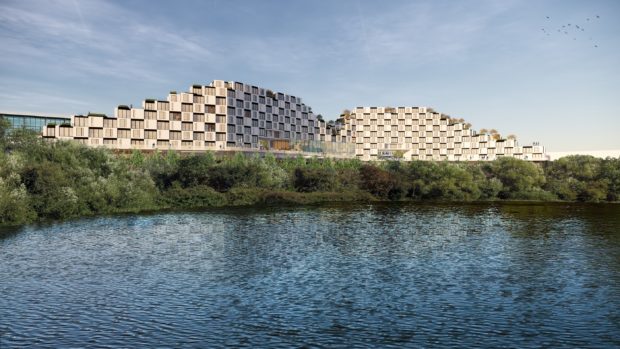Controversial plans to build hundreds of flats on the edge of Aberdeen’s famous Rubislaw Quarry have been recommended for approval.
More than 425 letters of objection were sent to council planners on Carttera’s application to build 245 apartments at the heritage site.
But councillors have been recommended to back the detailed proposals at their planning meeting next week, on the condition the Canadian developer agrees to pay to boost local services.
The proposed site lies on the northern edge of the quarry from which millions of tonnes of rock were extracted before its 1971 closure – earning the Granite City its nickname.
Carttera’s plans include a residents-only gym, function room, public bistro and promenade above the historic site are a scaled-back version of previously rejected ideas.
Planning permission for 116 flats at Rubislaw approved in 2006, mainly over five floors, is still valid.
More than 10 years later, proposals worth £68million for very nearly 300 homes on the same site were refused – in the face of then-recordbreaking opposition.
Those 2018 plans were rejected in spite of the recommendations of planning officials, and the rejection was upheld when it was referred to Scottish ministers.
More than 300 objections were submitted on that occasion – outweighed by the levels of protest this time around.
Carttera has agreed to contribute more than £3.3m to pay for affordable housing, which will be built elsewhere because of foreseen difficulties in maintaining the required 61 units within the development.
A further £257,000 to boost the school roll at nearby Hazlehead Academy, improve Hazlehead Park and to fund further health facilities in the city centre is also required.
Despite concerns the planned building was “prison block” in style and would “dominate the skyline”, senior council planner Matthew Easton states in his report: “The building is not considered to represent overdevelopment or to have an unacceptable impact on the character and amenity of the surrounding area.
“The building would sit comfortably within the site, due the surrounding topography and landscape and through the careful design of its scale, massing and form.
“The nine-storey height is not consistent across the building.”
He also stressed that objections based on the desire to see a heritage centre built on the south side of the site was not a material reason to halt the development to the north.
Hugh Black gained approval for plans to celebrate the quarry’s historic ties to the city’s identity in 2015 but the permission has since elapsed.
Last night Mr Black said: “In our view, the revised planning application due to be considered on Monday remains unchanged and does not go far enough to satisfy the considerable swell of public objection to this development, particularly in relation to the mass, height and design.
“This proposal has more than doubled the amount of flats approved in 2006 and almost doubled the height, so anyone arguing this is not overdevelopment is misguided.
“I have every confidence that councillors will make the right decision to reject this revised proposal.
“I make no apology and will to continue to do what is best for Rubislaw Quarry and its immediate surroundings.”
